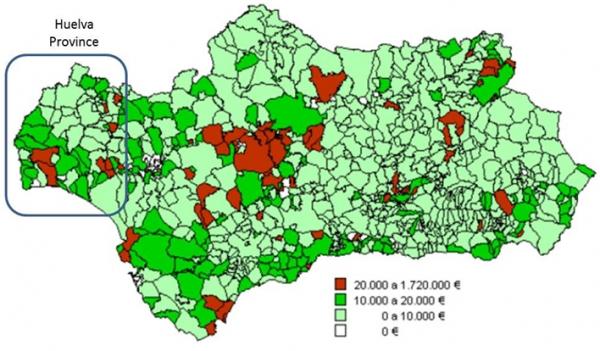Policy context
Agricultural Policy (Andalucía)
| Authors: | Michiel Curfs, Anton Imeson, Marit de Vries |
| Coordinating authors: | Constantinos Kosmas, Agostino Ferrara, Ruta Landgrebe, Sandra Nauman |
| Editors: | Alexandros Kandelapas, Jane Brandt |
Editor's note 20Mar14: Sources D142-6. and D342-4.
In Spain, the EU rural development policy is implemented through Rural Development Programs (RDPs), established at the regional level. Funding is provided through the European Agricultural Fund for Rural Development (EAFRD). The RDP of Andalucía 2007-2013 sets three main objectives.
- Increasing the competitiveness of agriculture and forestry in the rural area (human potential, physical potential, quality of products, innovation.
- Improving the environment and the countryside.
- Ensuring the quality of life in rural areas and diversifying the rural economy, as well as strengthening territorial cohesion.
The RDP budget (2007-2013) exceeds €2 billion of which the EAFRD (with 75% public contribution). Of this total budget for rural development planning in Andalucía, about 10% is devoted to the execution of the LEADER programme. The other 90% is expenditure for strengthening the competitiveness of the agricultural and forestry sectors (43%), improving the rural environment (45%), enhancing the quality of life and diversification of the rural economy (1%) and technical assistance (0.7%).
Among other initiatives led by the Spanish Government and the Autonomous Communities, the Spanish Law 45/2007 of 13 December on Sustainable Rural Development regulates and establishes measures to promote the sustainable development of rural areas assuming basic conditions to guarantee equal rights to all Spanish citizens and the management of socioeconomic activities in rural areas. Supporting local entrepreneurship is one of the main routes that is promoted to keep the younger population from leaving the area and to generate more attractive and sustainable livelihoods.
Various departments of the Government of Andalucía are involved in policy formulation and implementation :
- The Regional Ministry of Agriculture, Fisheries and Environment.
- The Regional Ministry of Economy and Finance and the Andalucían Institute of Agricultural Research and Training, Fisheries, and Food Organic Production (IFAPA).
- The Regional Ministry of Public Works.
- The Regional Ministry of Tourism.
- Provincial and City Councils (local authorities).
- Local action groups (LAGs) acting as intermediaries of the Junta de Andalucía (regional government) for reimbursement for rural development funds. The study site LAG is ADRAO (Association for the development of Rural Baixo Guadiana), which also includes the commonwealth Beturia (mancomunidad Beturia), a unification of several municipalities.
Additional policy instruments The Andalucían Sustainable Rural Development programme has a budget of almost €800M as well as various long-term projects, (LiderA Programme, AVIVA Programme). The Western Andévalo and Baixo Guadiana study sites have participated in successive versions of the LEADER programs since 1994 through ADRAO which has been labelled an ‘entrepreneurial’ type of LAG by the Junta de Andalucía in the evaluation report of the LEADER II program due to its collaboration with entrepreneurs and their associations in the region. ADRAO has also realised several projects for entrepreneurs (DINAMIZACIÓN DEL ANDÉVALO OCCIDENTAL, Intrarural etc).
Impact and effectiveness. Since 1986, the CAP has supported the production of cereals, meat (cattle, sheep, goats) in the Dehesas and the expansion of forest plantations through subsidies.

While the shift in competence from state to autonomous communities has led to a strengthening of the power within rural areas, confusion within the national government over its own influence and control regarding RD still exists. On the other hand rural unemployment figures remain high, as in all of Spain. A movement of younger persons back to rural areas is noticeable.
In addition, interviews point to the existence of multiple plans and reports without however equal examination of their execution. It has also been noted that despite available finance, local and private participation remains limited while the import of expertise from urban centres may constitute a problem for project execution. In this context, public participation in the planning process is very important.
